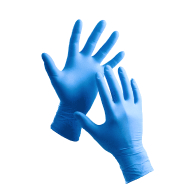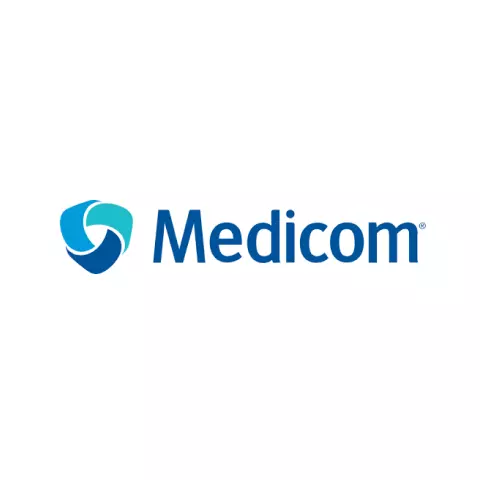Medicom SafeTouch® Connect Rejuvenate Latex Glove, Natural
Product description
Medical-grade latex gloves designed for healthcare professionals, featuring superior elasticity and excellent dexterity. These powder-free gloves are enriched with lanolin and vitamin E to promote skin hydration and comfort during extended use. The micro-textured fingertips ensure precise grip and enhanced object manipulation.
Product Features:
- Superior elasticity and dexterity
- Micro-textured fingertips for excellent grip
- Enriched with lanolin and vitamin E for skin hydration
- Powder-free design
- SafeTouch® Connect Rejuvenate technology
Technical Details:
- Material: Natural latex
- Contraindication: Contains allergenic proteins
Standards:
- EU Regulation 2017/745 on Medical Devices
- MD Class I certification
- PPE Category Cat. III
- CE marked
Recommended Applications:
- Healthcare facilities
- Medical procedures
Indicates the glove's pigmentation, which can aid in color-coding tasks, enhancing visibility, or meeting specific industry requirements for contamination control.
Describes whether fingertips have a smooth or textured surface, affecting grip strength, tactile sensitivity, and handling precision for various applications.
Defines how the wrist portion of the glove is finished, affecting ease of donning, security during use, and resistance to tearing when putting on.
Designed for use on either hand, these gloves offer convenience and efficiency. Their symmetrical design simplifies donning and reduces waste.
Offers versatile hand protection for various tasks. Balances durability and flexibility, suitable for diverse applications requiring barrier protection.
Offers complete hand coverage, ensuring hygiene and protection. Ideal for various tasks requiring a barrier against contamination and maintaining cleanliness.
Measurement of material thickness in the palm area, affecting protection level, durability, and dexterity. Critical for matching gloves to specific tasks.
Measures from fingertip to cuff end, determining wrist/forearm coverage. Longer gloves provide enhanced protection against splashes and contaminants.
Measures the material thickness in the finger areas, balancing protection against punctures and chemicals with tactile sensitivity for precision tasks.
Indicates whether gloves contain donning powder. Powder-free options reduce allergen risks and contamination, while powdered versions offer easier application.
Indicates the composition of the gloves, affecting properties like elasticity, chemical resistance, allergen potential, and suitability for specific tasks.
- Chemical Resistance
- Water Resistance
- Slip Resistant
- Hand Protection
Request a free sample
Test first and buy later. Visit any product page to request your free sample.
Standards and labels
EN 374-5:2016 is a European standard for gloves that protect against microorganisms, specifically gloves that are used for medical and dental procedures. It sets rules for how the gloves should protect against microorganisms and how to test if they meet the standards. Gloves that pass the tests can have a label that says they meet the standard. The test results can be pass or fail for each test that checks the gloves resistance to microorganisms.
Test results
Micro-organisms Bacteria & FungiEN 374-5:2016 specifies the requirements and test methods for protective gloves intended to protect against bacteria and fungi. The designation 'Bacteria & Fungi' indicates that the gloves have been tested and verified to provide effective barrier protection against microbial agents. The testing involves evaluating the glove's material and seams for their impermeability to microorganisms under conditions that simulate real-world use, ensuring no penetration occurs through the glove material or at the seams. Gloves certified under this standard are crucial for use in environments such as healthcare, laboratory settings, and any applications where preventing the transmission of infectious agents is essential. They help ensure the safety and hygiene of workers by providing reliable protection against the risks of bacterial and fungal contamination.
Micro-organisms VirusEN 374-5:2016 is a standard that outlines the requirements and testing methods for protective gloves designed to protect against viruses. The designation 'Virus' indicates that the gloves have passed specific tests confirming their barrier effectiveness against viruses. These tests involve assessing the glove material's resistance to penetration by blood-borne pathogens and other virus-containing fluids, using a bacteriophage as a surrogate virus due to its small size and resistance. Gloves that meet this standard are vital in healthcare settings, laboratories, and any environment where there is a risk of exposure to viral infections. They are crucial for preventing the transmission of diseases, ensuring that workers are protected when handling potentially infectious materials, thus enhancing safety and health protocols in workplaces with biological hazards.
ISO 13485:2016 is a standard that specifies requirements for a quality management system for the design and manufacture of medical devices. It includes requirements for how companies should design, implement, maintain and improve their quality management system to ensure that their medical devices are safe and effective. Test results can include information on how well the quality management system is functioning, how well it is being followed, and how effective it is in preventing defects. The standard also includes requirements for how the company should document and record their quality management system performance and continuously improve it.
Test results
Medical Management PassedThe ISO 13485:2016 standard is specifically tailored for medical device manufacturers and aims to ensure the quality and safety of medical devices throughout their production and lifecycle. A test result of Passed in the context of the ISO 13485:2016 standard signifies that the medical device manufacturing management system under assessment has successfully met all regulatory and safety requirements stipulated in the standard. This encompasses rigorous evaluations of the manufacturer's quality management system, including processes like risk management, regulatory compliance, and effective process control. The assessment involves auditing processes such as document review, facility inspection, and staff interviews, to verify the adequacy and effectiveness of the quality management system. Meeting the ISO 13485:2016 requirements assists manufacturers in achieving and maintaining regulatory compliance and ensures that their products consistently meet user needs and applicable regulatory standards, which is crucial for entry and continued presence in global markets.
Test results
General Requirements GuideEN ISO 21420:2020 is a standard that outlines general requirements and guidelines for protective gloves, aiming to ensure their quality, performance, and suitability for various applications. When a product meets the requirements outlined in the General Requirements section of EN ISO 21420:2020, it signifies that the gloves comply with fundamental quality and performance criteria, including factors such as size, fit, ergonomics, and dexterity. The practical implications of this compliance are significant, as it assures users of the gloves' basic functionality and suitability for general hand protection purposes across a range of industries and applications. The test method involves evaluating various aspects of the gloves, including dimensions, construction, materials, and labeling, to ensure conformity with the specified requirements. Compliance with these general requirements enhances user confidence in the protective gloves' reliability and effectiveness, promoting workplace safety and facilitating compliance with regulatory standards.
EN ISO 9001:2015 is a standard that sets out the requirements for a quality management system (QMS). It is a set of guidelines that organizations can follow to ensure that they meet customer requirements and enhance customer satisfaction. The standard is based on the plan-do-check-act model and focuses on continuous improvement. It covers the design, development, production, installation, and servicing of products. Organizations can get certified to this standard, which means that they have been independently audited and found to meet the requirements of the standard. The certification process includes regular audits to ensure that the organization continues to meet the standard's requirements.
Test results
Service Reliability PassedEN ISO 374-2:2019 is a standard that tells how gloves should be made to protect hands from dangerous chemicals and microorganisms. It sets rules for design, materials, and testing of gloves. Possible test results include how well the gloves keep out chemicals, how long they last and how well they protect the hands. This standard specify the test methods and the performance requirements for gloves protecting against specific microorganisms and chemicals.
EN 455-3:1999 is a European standard for disposable medical gloves. It sets out the definition, performance requirements and test methods for this type of gloves. The standard includes requirements for physical properties, dimensions, packaging, freedom from holes and freedom from powder. Test results can include measurements of the gloves' physical properties, dimensions, packaging, freedom from holes and freedom from powder.
Test results
Biological Evaluation TestedThe EN 455-3:1999 standard evaluates the biological safety of medical gloves for single use. It focuses on tests that determine acceptable levels of endotoxins, protein content to minimize allergic reactions, and leachable substances which could have harmful effects. Essentially, the test results from EN 455-3:1999 determine if the tested gloves release any potential allergens or toxic chemicals that could harm users, ensuring product safety in regards to biological factors.
EN 455-2:2009 is a European standard for disposable medical gloves. It sets out the definition, performance requirements and test methods for this type of gloves. The standard includes requirements for physical properties, dimensions, packaging, freedom from holes, freedom from powder and freedom from protein. Test results can include measurements of the gloves' physical properties, dimensions, packaging, freedom from holes, freedom from powder and freedom from protein. This version of the standard includes some changes and updates from the 2000 version.
Test results
Physical Properties TestedEN 455-2:2009 is a European Standard specifically designed for determining the physical properties of medical gloves. The result showing that gloves have been tested under EN 455-2:2009 indicates that the gloves meet the criteria for physical performance as prescribed by this standard. The testing method, as laid out in EN 455-2:2009, includes assessments of the gloves’ tensile strength and elongation before and after aging, force at break, and dimensions, among other properties. This rigorous testing ensures that the medical gloves will perform reliably under typical conditions of use. Compliance with this standard is critical for gloves used in medical settings, as it confirms the product's capability to withstand practical use without failure, ensuring safety and effectiveness for both healthcare providers and patients.
EN 455-1:2020 is a European standard for disposable medical gloves. It sets out the definition, performance requirements and test methods for this type of gloves. The standard includes requirements for freedom from holes, tensile strength, elongation, packaging, freedom from powder, freedom from protein, freedom from endotoxins, and freedom from pyrogens. Test results can include measurements of the gloves' freedom from holes, tensile strength, elongation, packaging, freedom from powder, freedom from protein, freedom from endotoxins and freedom from pyrogens. This version of the standard includes some changes and updates from the 2000 version.
EN 455-4:2009 is a European standard for disposable medical gloves. It sets out the definition, performance requirements and test methods for this type of gloves. The standard includes requirements for freedom from holes, dimensions, packaging, freedom from powder, freedom from protein and freedom from endotoxins. Test results can include measurements of the gloves' freedom from holes, dimensions, packaging, freedom from powder, freedom from protein and freedom from endotoxins.
CE Marking is a label that shows a product meets certain safety and environmental standards set by the European Union. To get the CE Marking, a company must test and certify their product meets these standards. CE Marking is required for many products sold in the EU, including electronics, machinery, toys and medical devices. It helps ensure that products are safe for consumers and the environment, and allows for easy trade within the EU.
MD stands for "Medical Device." It refers to any instruments, apparatus, machines, implants, or other similar or related articles that are intended to be used for human beings for the purpose of diagnosis, prevention, monitoring, treatment or alleviation of disease, injury or disability. In Europe, a MD Label is a special label that must be on all Medical Devices that are sold or used in the European Union (EU). The label must include information about the product, such as the name of the manufacturer, the intended use of the product and CE mark. To be able to sell or use a Medical Device in the EU, the device must meet certain standards and requirements set by the European Union and notified body.
PPE stands for "personal protective equipment." PPE Category 3 refers to equipment that is complex and provide the highest level of protection such as powered respirators, SCBA, and full body suits. In Europe, PPE Category 3 must meet certain safety standards set by the European Union, which means that it must be designed and manufactured to protect the user without causing harm. Companies that make or sell PPE must prove that it meets these standards. They also must have a quality management system in place, have to be audited regularly by a notified body and have to have a technical documentation.
Medicom delivery terms
Free delivery when you order more than 150,00 € from Medicom
Supplier shipping fee 6,33 €
Brand minimum 200,00 €
Price available on request
Shipping fee is 6,33 € for orders under 150,00 €
A carton contains 10 packages (1 000 pieces)
Need larger quantities?
Other products you may like
Recently viewed
Need help?
Get help from our experts
Other products you may like
Similar products you may like
Recommended for you
Medicom
Delivery time: 5 business days
Orders from 200,00 €
Supplier shipping fee 6,33 €
Free shipping on orders over 150,00 €



Find +150,000 products from hundreds of brands
Autonomous sourcing platform
The most efficient way to source and order supplies for your operations
Sourcing
Ordering
List products you’re looking for and we’ll find the best products and prices for you – all for free.
Need help?
Get help from our experts

